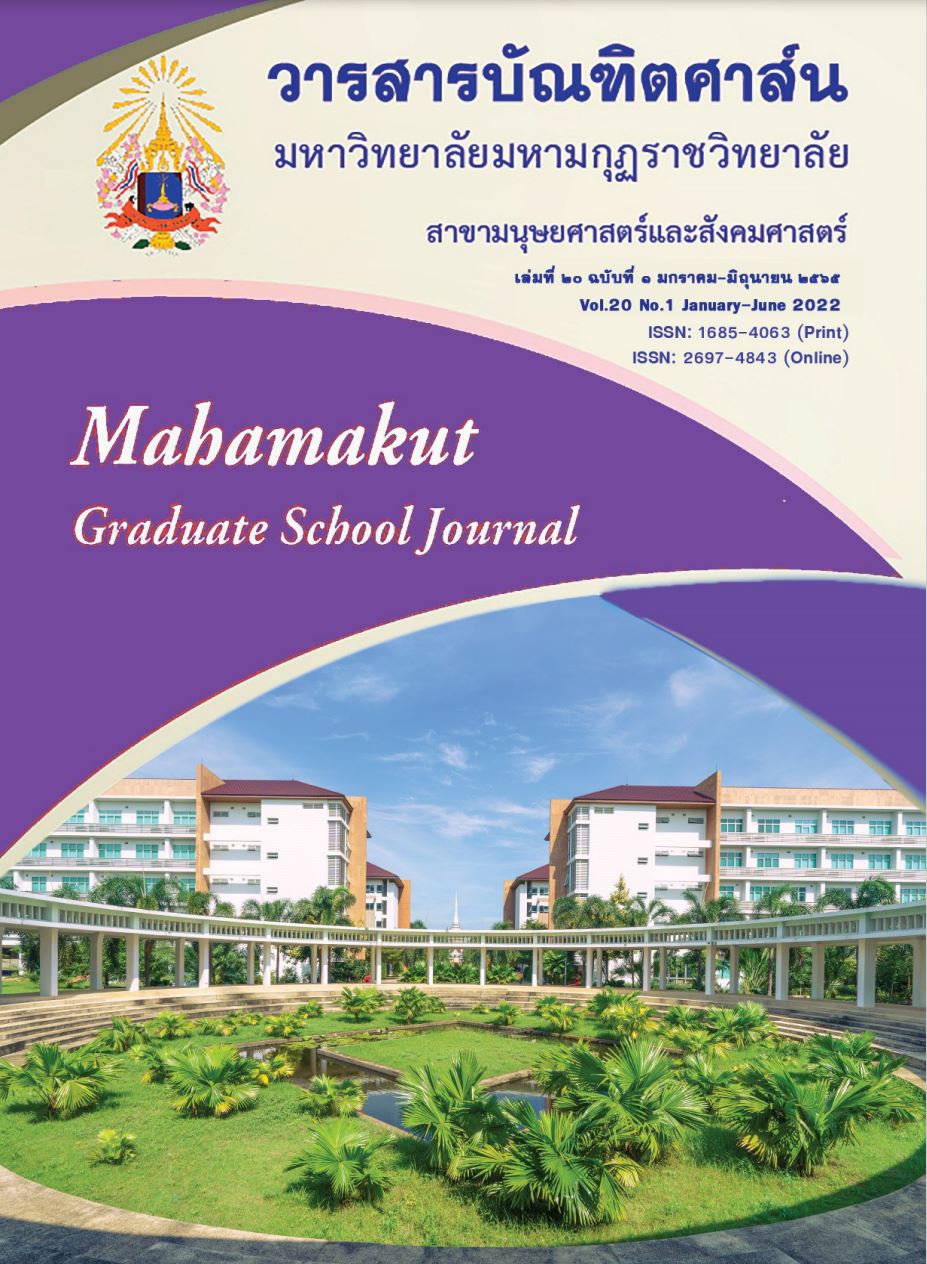องค์ประกอบการบริหารทรัพยากรมนุษย์ของผู้บริหารหน่วยอภิธรรมโชติกะวิทยาลัย สังกัดมหาวิทยาลัยมหาจุฬาลงกรณราชวิทยาลัย
คำสำคัญ:
องค์ประกอบการบริหารทรัพยากรมนุษย์, หน่วยอภิธรรมโชติกะวิทยาลัยบทคัดย่อ
การวิจัยครั้งนี้มีวัตถุประสงค์ เพื่อ 1) ศึกษาองค์ประกอบแบบการบริหารทรัพยากรมนุษย์ของผู้บริหารหน่วยอภิธรรมโชติกะวิทยาลัย และ 2) พัฒนาองค์ประกอบการบริหารทรัพยากรมนุษย์ของผู้บริหารหน่วยอภิธรรมโชติกะวิทยาลัย โดยใช้วิธีวิจัยแบบผสมผสาน กลุ่มตัวอย่าง คือ หน่วยอภิธรรมโชติกะวิทยาลัย 34 หน่วย ผู้ให้ข้อมูล ได้แก่ ผู้บริหาร คณะกรรมการบริหาร และครูผู้สอนในหน่วยอภิธรรมโชติกะวิทยาลัย จำนวน 340 รูป/คน เครื่องมือที่ใช้ได้แก่ แบบสัมภาษณ์กึ่งโครงสร้าง แบบสอบถาม วิเคราะห์ข้อมูลด้วยสถิติ ค่าความถี่ ค่าร้อยละ ค่าเฉลี่ย ส่วนเบี่ยงเบนมาตรฐาน และการวิเคราะห์องค์ประกอบเชิงยืนยัน โดยใช้โปรแกรมสำเร็จรูปทางสถิติ
ผลการวิจัยพบว่า:
- ผลการศึกษาองค์ประกอบการบริหารทรัพยากรมนุษย์ของผู้บริหารหน่วยอภิธรรมโชติกะวิทยาลัย ประกอบด้วย 4 องค์ประกอบหลัก 16 องค์ประกอบย่อย
- ผลการพัฒนาองค์ประกอบการบริหารทรัพยากรมนุษย์ของผู้บริหารหน่วยอภิธรรมโชติกะวิทยาลัย ได้องค์ประกอบที่มีความสอดคล้องกับข้อมูลเชิงประจักษ์ โดยมีค่า χ2/df = 1.952, GFI = 0.951, AGFI = 0.949 และ RMSEA = 0.000 ได้ 4 องค์ประกอบหลัก คือ 1) ด้านการธำรงรักษาบุคลากร มี 3 องค์ประกอบย่อย คือ 1.1) มาตรการดึงดูด พัฒนา รักษาพนักงานที่มีทักษะหรือสมรรถนะสูง 2) การสร้างความพึงพอใจในการทำงาน 1.3) นโยบาย แผนงาน และมาตรการด้านการบริหารทรัพยากรมนุษย์ 2) ด้านการบริหารทรัพยากรมนุษย์ มี 5 องค์ประกอบย่อย คือ 2.1) การฝึกอบรมและพัฒนา 2.2) การประเมินผลการปฏิบัติงาน 2.3) ค่าตอบแทนและสวัสดิการ 2.4) การคัดเลือกบุคลากร 2.5) การสรรหาบุคลากร 3) ด้านการสร้างแรงจูงใจในการทำงาน มี 4 องค์ประกอบย่อย คือ 3.1) ความต้องการทางด้านร่างกาย 3.2) ความต้องการความปลอดภัยและความมั่นคง 3.3) ความต้องการในการประสบผลสำเร็จในชีวิต 3.4) ความต้องการทางสังคม และ 4) ด้านวัฒนธรรมองค์กร มี 4 องค์ประกอบย่อย คือ 4.1) ระดับความมั่นคงขององค์กร 4.2) ความรู้สึกเป็นส่วนหนึ่งหรือความเป็นเจ้าของ 4.3) เรื่องราว พิธีการ และพิธีกรรมขององค์กร 4.4) ค่านิยม
เอกสารอ้างอิง
กัลยา วานิชย์บัญชา. (2551). การวิเคราะห์สถิติชั้นสูงด้วย SPSS for Windows. พิมพ์ครั้งที่ 3. กรุงเทพฯ : ธรรมสาร.
ปิยาพร ห้องแซง. (2555). การบริหารทรัพยากรมนุษย์ที่มีผลต่อความผูกพันและความพึงพอใจในการทํางานในองค์กรของพนักงานสาขาธนาคารออมสินในเขตกรุงเทพมหานคร. มหาวิทยาลัยศรีนครินทรวิโรฒ.
พิชิต พิทักษ์เทพสมบัติ. (2552). ความพึงพอใจในงาน และความผูกพันกับองค์กร: ความหมาย ทฤษฏี วิธีวิจัย การวัด และการวิจัย. กรุงเทพฯ : เสมาธรรม.
หน่วยอภิธรรมโชติกะวิทยาลัยวัดราชาธิวาสวิหาร. (2560). เรื่องการศึกษาปัญหาและการบริหารจัดการการศึกษาของหน่วยอภิธรรมโชติกะวิทยาลัย. รายงานการประชุมหน่วยอภิธรรมโชติกะวิทยาลัย วัดราชาธิวาสวิหาร.
Dessler, Gary. (2009). A framework for human resource management. (5th ed). Upper Saddle River, New Jersey: Pearson Education.
Dubrin, A.J. (2005). Fundamentals of Organizational Behavior. (3rd ed). Canada.
Esteghamati, A., Zandieh, A, Khalilzadeh, O., Meysamie, A., & Ashraf, H. (2010). Clustering of metabolic syndrome components in a Middle Eastern diabetic and non-diabetic population. Diabetol Metab Syndrome. 36(2), 36.
Flippo, E.B. (1996). Principle of Personal Management. New York: Mc.Graw Hill.
Kline, R. B. (2005). Principles and Practice of Structural Equation Modeling. (2nd ed). New York: Guilford.
Mondy R.W., R.M. Noe and S.R. Premeaux. (1999). Human Resource Management. (7thed.). New Jersey : Prentice Hall.
Oldroyd, D. (2005). Leadership and Management in Education. New York : Oxford University Press.
Ulrich, B. (2010). Nicht ohne Volk! Die Zeit. [Online]. Retrieved July 15, 2019, from www.zeit.de/2010/22/Habermas-Replik/komplettansicht
Zaini Abdullah. (2009). The Effect of Human Resource Management Practices on Business. Performance among Private Companies in Malaysia. International Journal of Business and Management. 4, 6 (June): 65-72.
ดาวน์โหลด
เผยแพร่แล้ว
รูปแบบการอ้างอิง
ฉบับ
ประเภทบทความ
สัญญาอนุญาต
ลิขสิทธิ์ (c) 2022 มหาวิทยาลัยมหามกุฏราชวิทยาลัย

อนุญาตภายใต้เงื่อนไข Creative Commons Attribution-NonCommercial-NoDerivatives 4.0 International License.
บทความวิชาการและบทความวิจัยในวารสารฉบับนี้ถือเป็นความรับผิดชอบของผู้เขียนเท่านั้น บทความที่ได้รับการตีพิมพ์ในวารสารบัณฑิตศาส์น ถือเป็นลิขสิทธิ์ของมหาวิทยาลัยมหามกุฏราชวิทยาลัย ตามพระราชบัญญัติลิขสิทธิ์



